Discrete Element Method Analyses of Bond Degradation Evolutions for Cemented Soils
Abstract
1. Introduction
2. Materials and Methods
2.1. Bond Contact Model Framework
2.1.1. Particle Interaction
2.1.2. Prefailure Behavior of the Cementation Bond
2.1.3. Bond Failure Criterion
2.2. DEM Simulations
2.2.1. Sample Preparation
2.2.2. Simulation Execution
3. Results
3.1. Bond Degradation Evolutions
3.2. Compression Tests
3.3. Conventional Triaxial Tests
3.4. True Triaxial Tests
4. Discussion
5. Conclusions
- (1)
- The bond degradation variables BN, B0, and Bσ represent the extent to which the soil bonding is damaged. A degradation variable of 0/1.0 indicates that the applied stress is completely sustained by the bonded aggregates/unbounded grains.
- (2)
- The bond degradation variables BN and B0 increase with the equivalent plastic strain until they reach 1.0 under varying stress paths. The evolutions of both variables are influenced by the principal stress ratio, confining stress, and coefficient b, especially for the sample with strong bonds.
- (3)
- In compression tests with principal stress ratios higher than 0.4, B0 is smaller than the corresponding BN, indicating the priority of the bonded contacts to sustain the applied loads. In triaxial tests, B0 is smaller than BN before the intermediate stage of shearing, and then B0 evolves to be near or larger than BN at the end of shearing when the stress state approaches the strength envelope.
- (4)
- The evolutions of the further developed bond degradation variable Bσ under different stress paths are approximately coincident with each other. The collective data of Bσ can be effectively fitted by an exponential or a hyperbolic evolution law.
Author Contributions
Funding
Data Availability Statement
Conflicts of Interest
Abbreviations
| contact radius of particle interaction | |
| shape parameter | |
| common radius of a particle pair | |
| van der Waals force | |
| normal force of particle interaction | |
| tangential force of particle interaction | |
| rolling moment of particle interaction | |
| twisting torque of particle interaction | |
| normal stiffness of particle interaction | |
| tangential stiffness of particle interaction | |
| rolling stiffness of particle interaction | |
| twisting stiffness of particle interaction | |
| normal overlap between a particle pair | |
| relative shear displacement increment | |
| relative rotation increment | |
| relative twist increment | |
| friction coefficient between a particle pair | |
| interparticle effective modulus | |
| normal-to-shear stiffness ratio | |
| bond radius multiplier | |
| bond radius | |
| bond normal force | |
| bond tangential force | |
| bond rolling moment | |
| bond twisting torque | |
| bond normal stiffness | |
| bond tangential stiffness | |
| bond rolling stiffness | |
| bond twisting stiffness | |
| relative normal displacement increment | |
| bond thickness | |
| bond effective modulus | |
| bond modulus reduction factor | |
| bond normal-to-shear stiffness ratio | |
| compressive strength of the bond material | |
| tensile strength of the bond material | |
| bond compressive strength | |
| bond tensile strength | |
| bond tension-to-compression strength ratio | |
| bond shearing strength | |
| bond rolling strength | |
| bond twisting strength | |
| bond thickness threshold | |
| , and | principal stresses of a stress tensor |
| , and | principal strains of a stain tensor |
| mean stress | |
| deviator stress | |
| volumetric strain | |
| deviator strain | |
| average stress tensor of a representative volume element | |
| bond degradation variable based on the number of unbonded contacts | |
| bond degradation variable based on the stress contribution of unbonded contacts | |
| equivalent plastic strain | |
| volumetric plastic strain | |
| deviator plastic strain | |
| bond degradation variable considering stress effect | |
| stress ratio | |
| strength potential | |
| yield surface size of a cemented soil | |
| yield surface size of corresponding uncemented soil |
References
- Mitchell, J.K. Fundamentals of Soil Behavior; Wiley: New York, NY, USA, 1976. [Google Scholar]
- Leroueil, S.; Vaughan, P.R. The general and congruent effects of structure in natural soils and weak rocks. Géotechnique 1990, 40, 467–488. [Google Scholar] [CrossRef]
- Burland, J.B. On the compressibility and shear strength of natural clays. Géotechnique 1990, 40, 329–378. [Google Scholar] [CrossRef]
- Yang, R.Y.; Zou, R.P.; Yu, A.B. Computer simulation of the packing of fine particles. Phys. Rev. E 2000, 62, 3900–3908. [Google Scholar] [CrossRef] [PubMed]
- Zourmpakis, A.; Boardman, D.; Rogers, C.; Jefferson, I.; Gunn, D.; Jackson, P.; Northmore, K.; Entwisle, D.; Nelder, L.; Dixon, N. Case study of a loess collapse field trial in Kent, SE England. Q. J. Eng. Geol. Hydrogeol. 2006, 39, 131–150. [Google Scholar] [CrossRef]
- Xu, L.; Dai, F.C.; Tham, L.G.; Tu, X.B.; Min, H.; Zhou, Y.F.; Wu, C.X.; Xu, K. Field testing of irrigation effects on the stability of a cliff edge in loess, North-west China. Eng. Geol. 2011, 120, 10–17. [Google Scholar] [CrossRef]
- Yu, H.S.; Tan, S.M.; Schnaid, F. A critical state framework for modelling bonded geomaterials. Geomech. Geoengin. Int. J. 2007, 2, 61–74. [Google Scholar] [CrossRef]
- Nova, R.; Castellanza, R.; Tamagnini, C. A constitutive model for bonded geomaterials subject to mechanical and/or chemical degradation. Int. J. Numer. Anal. Mech. Geomech. 2003, 27, 705–732. [Google Scholar] [CrossRef]
- Asaoka, A.; Nakano, M.; Noda, T. Superloading yield surface concept for highly structured soil behavior. Soils Found 2000, 40, 99–110. [Google Scholar] [CrossRef]
- Zhu, E.Y.; Yao, Y.P. Structured UH model for clays. Transp. Geotech. 2015, 3, 68–79. [Google Scholar] [CrossRef]
- Liu, W.H.; Li, W.G.; Zhang, H.Y.; Lin, X.Y.; Kong, G.Q.; Wang, L.; Hu, P. A critical state constitutive model for unsaturated structured soils. Comput. Geotech. 2022, 152, 104993. [Google Scholar] [CrossRef]
- Desai, C.S.; Toth, J. Disturbed state constitutive modeling based on stress-strain and nondestructive behavior. Int. J. Solids Struct. 1996, 33, 1619–1650. [Google Scholar] [CrossRef]
- Wu, Z.; Xu, J.; Li, Y.; Wang, S. Disturbed state concept–based model for the uniaxial strain-softening behavior of fiber-reinforced soil. Int. J. Geomech. 2022, 22, 04022092. [Google Scholar] [CrossRef]
- Shen, Z.J. An elasto-plastic damage model for cemented clays. Chin. J. Geotech. Eng. 1993, 15, 21–28. (In Chinese) [Google Scholar]
- Jiang, M.J.; Zhang, F.G.; Sun, Y.G. An evaluation on the degradation evolutions in three constitutive models for bonded geomaterials by DEM analyses. Comput. Geotech. 2014, 57, 1–16. [Google Scholar] [CrossRef]
- Nemat-Nasser, S.; Okada, N. Radiographic and microscopic observation of shear bands in granular materials. Géotechnique 2001, 51, 753–765. [Google Scholar] [CrossRef]
- White, D.; Take, W.A.; Bolton, M.D. Soil deformation measurement using particle image velocimetry (PIV) and photogrammetry. Géotechnique 2003, 53, 619–631. [Google Scholar] [CrossRef]
- Andò, E.; Hall, S.A.; Viggiani, G.; Desrues, J.; Bésuelle, P. Experimental micromechanics: Grain-scale observation of sand deformation. Geotech. Lett. 2012, 2, 107–112. [Google Scholar] [CrossRef]
- Cundall, P.A.; Strack, O.D.L. A discrete numerical model for granular assemblies. Géotechnique 1979, 29, 47–65. [Google Scholar] [CrossRef]
- Wang, Y.H.; Leung, S.C. A particulate-scale investigation of cemented sand behavior. Can. Geotech. J. 2008, 45, 29–44. [Google Scholar] [CrossRef]
- Jiang, M.J.; Li, T.; Hu, H.J.; Thornton, C. DEM analyses of one-dimensional compression and collapse behaviour of unsaturated structural loess. Comput. Geotech. 2014, 60, 47–60. [Google Scholar] [CrossRef]
- Cohen, E.; Klar, A. Micromechanical modeling of the effect of dissociation on the mechanical response of hydrate-bearing sediments. Granul. Matter 2022, 24, 84. [Google Scholar] [CrossRef]
- Li, T.; Li, L.; Liu, J.; Zhou, H. Influence of hydrate participation on the mechanical behaviour of fine-grained sediments under one-dimensional compression: A DEM study. Granul. Matter 2022, 24, 32. [Google Scholar] [CrossRef]
- He, J.; Zhu, H.; Zhou, M. DEM-Based Study on the Mechanical Behaviors of Pore-Filling MHBS under Drained True Triaxial Conditions Varying the Intermediate Stress Ratio of Constant Mean Effective Stresses. Int. J. Geomech. 2022, 22, 04022132. [Google Scholar] [CrossRef]
- He, J.; Li, T.; Rui, Y. Geomechanical Properties of Deep-Sea Pore-Filled Methane Hydrate-Bearing Soils at Critical State Using DEM Analysis. Fractal Fract. 2023, 7, 681. [Google Scholar] [CrossRef]
- Thornton, C. Numerical simulations of deviatoric shear deformation of granular media. Géotechnique 2000, 50, 43–53. [Google Scholar] [CrossRef]
- Jiang, M.J.; Liu, J.D.; Arroyo, M. Numerical evaluation of three non-coaxial kinematic models using the distinct element method for elliptical granular materials. Int. J. Numer. Anal. Mech. Geomech. 2016, 40, 2468–2488. [Google Scholar] [CrossRef]
- Itasca Particle Flow Code: User’s Manual. 2014. Available online: http://www.itascacg.com (accessed on 14 February 2024).
- Jiang, M.J.; Shen, Z.F.; Wang, J.F. A novel three-dimensional contact model for granulates incorporating rolling and twisting resistances. Comput. Geotech. 2015, 65, 147–163. [Google Scholar] [CrossRef]
- Li, T.; Jiang, M.J.; Thornton, C. Three-dimensional discrete element analysis of triaxial tests and wetting tests on unsaturated compacted silt. Comput. Geotech. 2018, 97, 90–102. [Google Scholar] [CrossRef]
- Li, T.; Jiang, M.; Li, L. DEM Analysis of Mechanical Behavior of Unsaturated Silt under Strain-Controlled Constant Stress Ratio Compression Tests. Int. J. Geomech. 2021, 21, 04021197. [Google Scholar] [CrossRef]
- Potyondy, D.O.; Cundall, P.A. A bonded-particle model for rock. Int. J. Rock Mech. Min. 2004, 41, 1329–1364. [Google Scholar] [CrossRef]
- Li, T. Three-Dimensional DEM Simulation and Constitutive Model of Unsaturated Structural Loess. Ph.D. Thesis, Tongji University, Shanghai, China, 2017. (In Chinese). [Google Scholar]
- Shen, Z.F.; Jiang, M.J.; Wan, R. Numerical study of inter-particle bond failure by 3D discrete element method. Int. J. Numer. Anal. Mech. Geomech. 2016, 40, 523–545. [Google Scholar] [CrossRef]
- Jiang, M.J.; Konrad, J.M.; Leroueil, S. An efficient technique for generating homogeneous specimens for DEM studies. Comput. Geotech. 2003, 30, 579–597. [Google Scholar] [CrossRef]
- Bagi, K. Stress and strain in granular assemblies. Mech. Mater. 1996, 22, 165–177. [Google Scholar] [CrossRef]
- Shen, Z.J. Breakage mechanics for geological materials: An ideal brittle-elasto-plastic model. Chin. J. Geotech. Eng. 2003, 25, 253–257. (In Chinese) [Google Scholar]
- Hu, Z.Q. Inundation Deformation Test and Numerical Analysis on Loess Structural Model and Loess Canal. Ph.D. Thesis, Xi’an University of Technology, Xi’an, China, 2000. (In Chinese). [Google Scholar]
- Charles, J.A. The use of one-dimensional compression tests and elastic theory in predicting deformations of rockfill embankments. Can. Geotech. J. 1976, 13, 189–200. [Google Scholar] [CrossRef]
- Maccarini, M. Laboratory Studies of Weakly Bonded Artificial Soil. Ph.D. Thesis, University of London, London, UK, 1987. [Google Scholar]
- Callisto, L.; Rampello, S. Shear strength and small-strain stiffness of a natural clay under general stress conditions. Géotechnique 2002, 52, 547–560. [Google Scholar] [CrossRef]
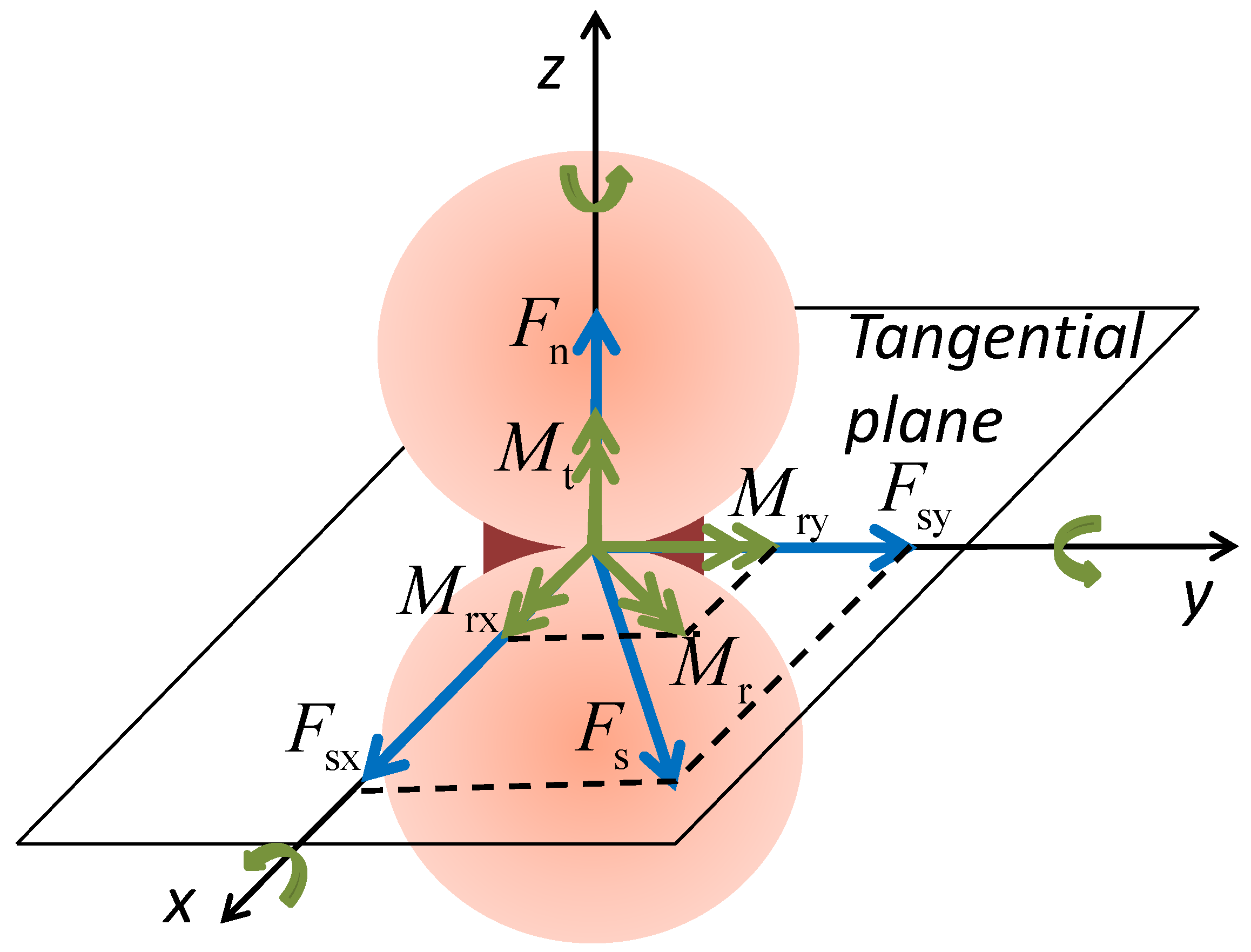



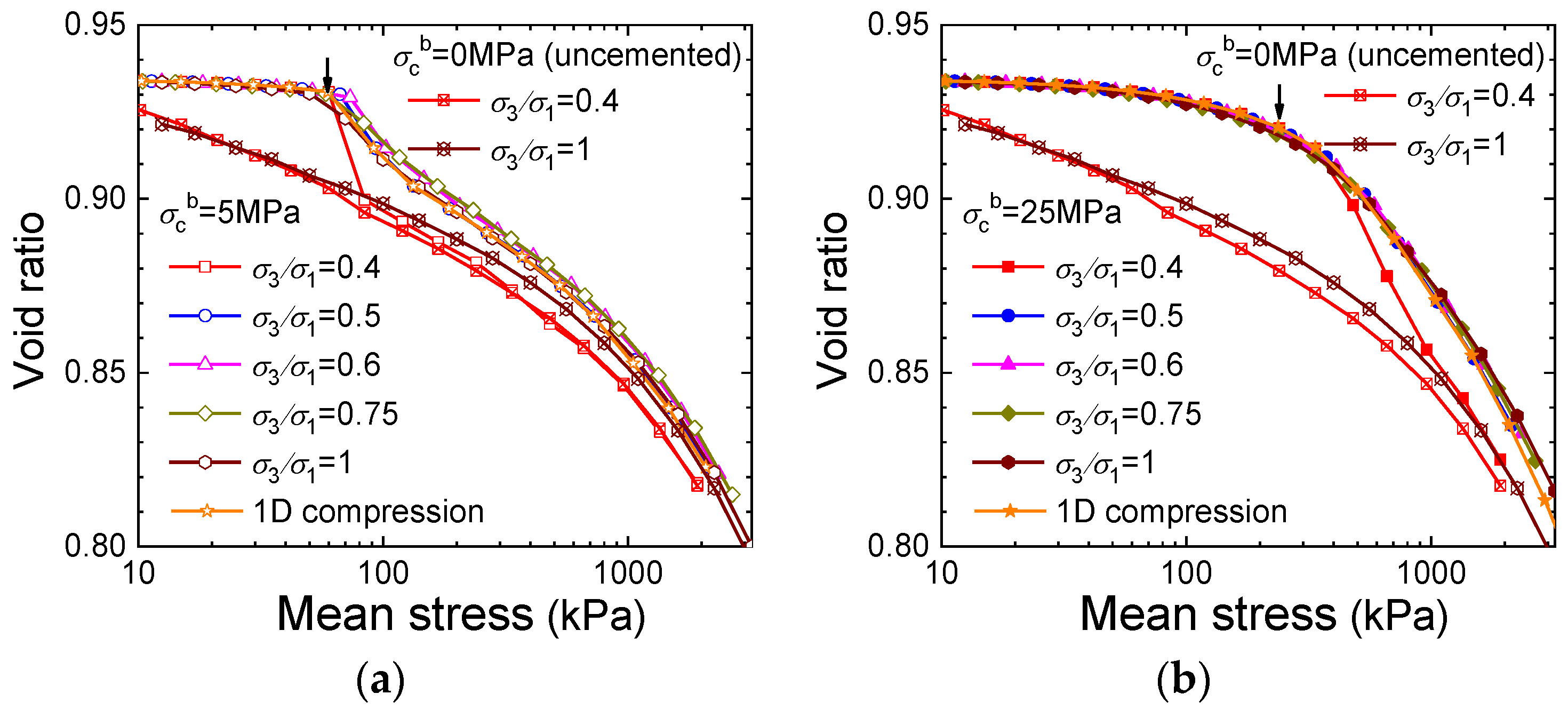
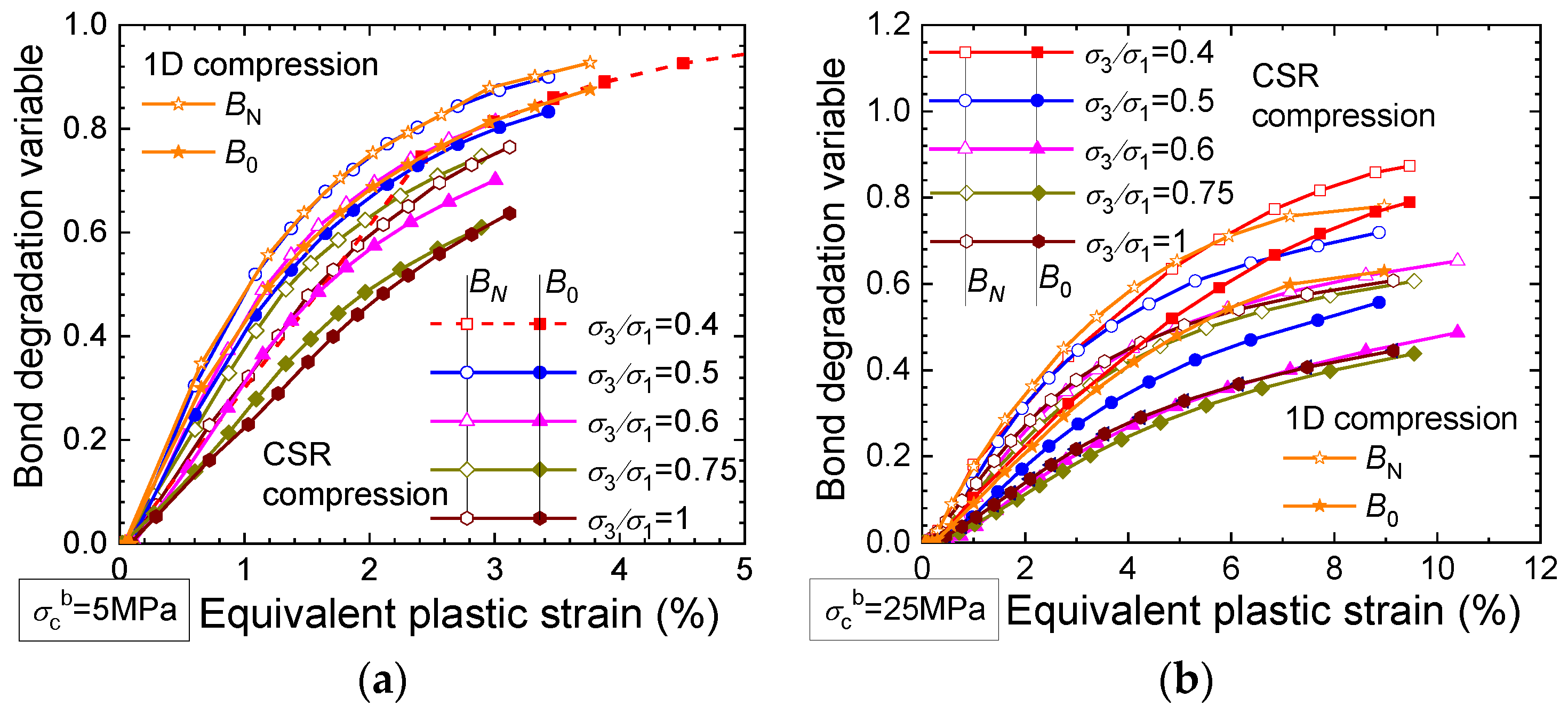
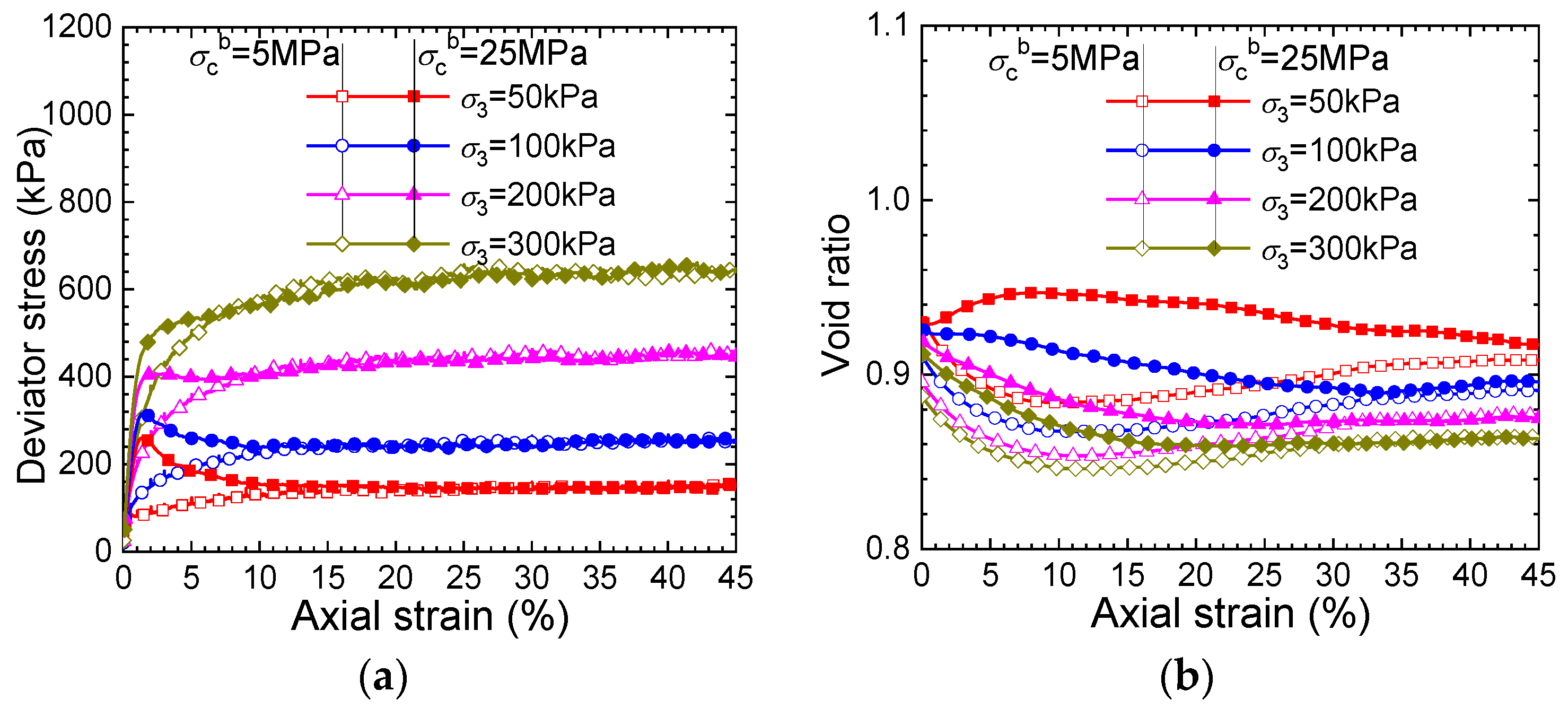



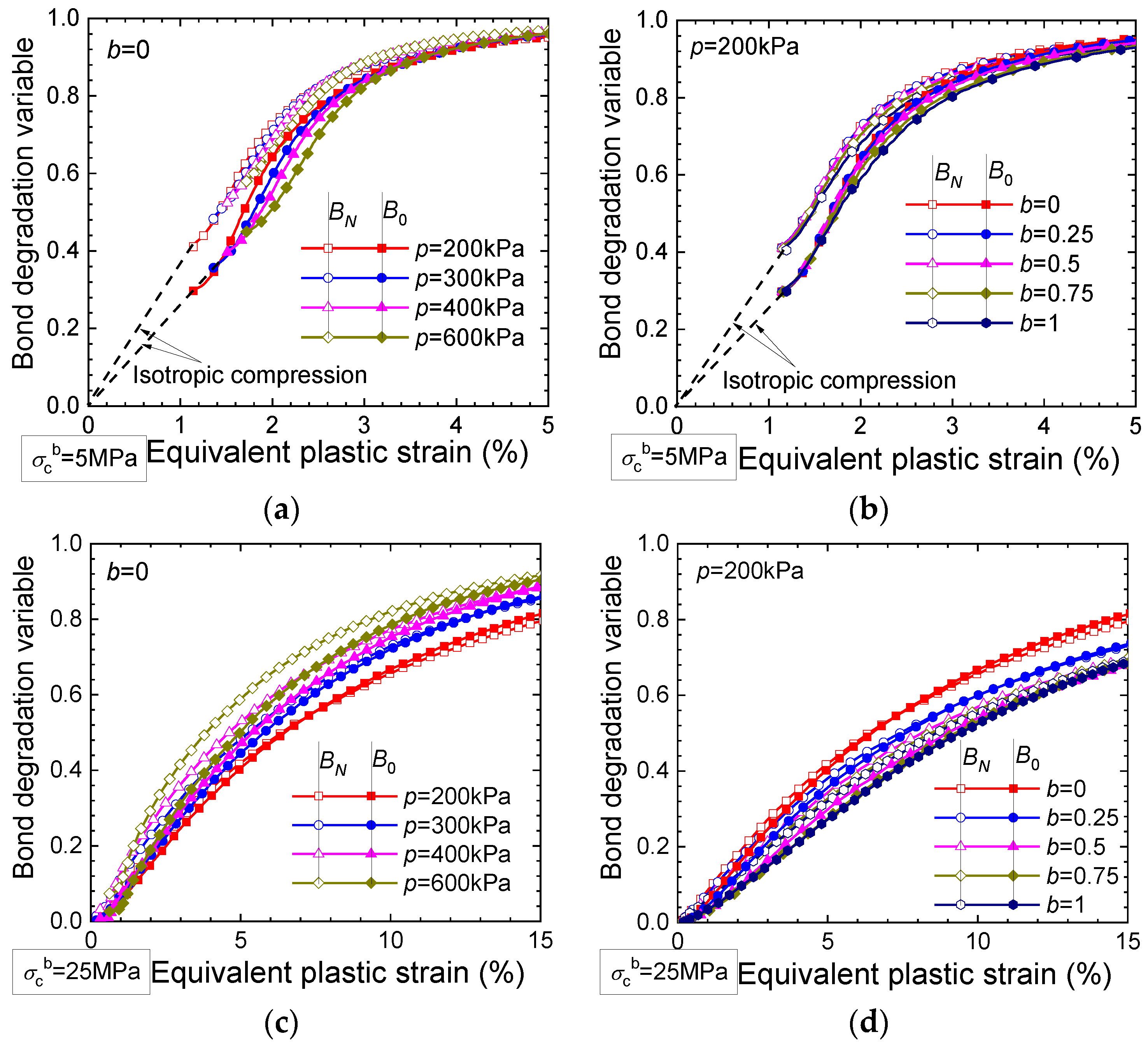

| Parameters | Values |
|---|---|
| Particle | |
| Particle density/kg·m−3 | 2710 |
| Local damping coefficient | 0.7 |
| Particle interaction | |
| Effective modulus /MPa | 800 |
| Normal-to-shear stiffness ratio | 1.5 |
| Friction coefficient μ | 0.5 |
| Shape parameter β | 0.21 |
| Van der Waals force Fv/N | 1.6 × 10−6 |
| Bond contact | |
| Bond effective modulus /MPa | 200 |
| Bond modulus reduction factor | 0.2 |
| Bond normal-to-shear stiffness ratio | 2.0 |
| Compressive strength of the bond material /MPa | 5; 25 |
| Bond tension-to-compression strength ratio | 0.1 |
| Bond radius multiplier | 0.35 |
| Bond thickness threshold | 0.1 |
Disclaimer/Publisher’s Note: The statements, opinions and data contained in all publications are solely those of the individual author(s) and contributor(s) and not of MDPI and/or the editor(s). MDPI and/or the editor(s) disclaim responsibility for any injury to people or property resulting from any ideas, methods, instructions or products referred to in the content. |
© 2024 by the authors. Licensee MDPI, Basel, Switzerland. This article is an open access article distributed under the terms and conditions of the Creative Commons Attribution (CC BY) license (https://creativecommons.org/licenses/by/4.0/).
Share and Cite
He, J.; Li, T.; Rui, Y. Discrete Element Method Analyses of Bond Degradation Evolutions for Cemented Soils. Fractal Fract. 2024, 8, 119. https://doi.org/10.3390/fractalfract8020119
He J, Li T, Rui Y. Discrete Element Method Analyses of Bond Degradation Evolutions for Cemented Soils. Fractal and Fractional. 2024; 8(2):119. https://doi.org/10.3390/fractalfract8020119
Chicago/Turabian StyleHe, Jie, Tao Li, and Yi Rui. 2024. "Discrete Element Method Analyses of Bond Degradation Evolutions for Cemented Soils" Fractal and Fractional 8, no. 2: 119. https://doi.org/10.3390/fractalfract8020119
APA StyleHe, J., Li, T., & Rui, Y. (2024). Discrete Element Method Analyses of Bond Degradation Evolutions for Cemented Soils. Fractal and Fractional, 8(2), 119. https://doi.org/10.3390/fractalfract8020119







